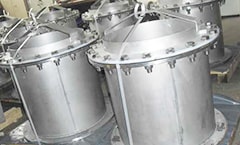
Telescopic Valves are designed to make them work with liquids and are always installed in upright positions. The main elements are the body, the obturator and the gasket mounted between them. The most characteristic aspect of these valves is the circular design of the body and the obturator, with both parts made basically from pieces of mechanically welded pipe. The body is primarily static, mounted on the run-off pipe flange in the pond, generally with a greater diameter. The moving part of the valve is called an obturator, its movement is linear and since it has a lesser diameter than the body, it is introduced inside the body of the valve. The gasket is mounted between the body and the obturator which is fixed to the body and closes on the exterior surface of the obturator.
There is an opening on the top of the obturator to discharge the fluid above the required level. Whenever the obturator is raised, the level in the pond comes up, on the other hand, if the obturator descends, the fluid above the obturator opening level will overflow, reducing the level in the pond. At the top of the obturator just above the opening, there is a flange in which the stem is bolted to this element transmits the force necessary to operate, as generated by the actuator, to the obturator. The stroke of the valve is defined by the difference between the maximum and minimum water level required. The length of both the obturator and the body depends on the required stroke.
Whenever the valve is fitted with a manual actuator, the stem protection cap id independent from the handwheel attachment nut, which means that the cap can be dismounted without having to release the entire handwheel. This advantage allows regular maintenance operations to be performed, such as lubricating the stem, etc. The stem of the valves is made from stainless steel and the handwheel is nodular cast iron. This material is highly resistant to bangs, making it more long-lasting than commonly used cast iron wheels. The yoke is designed compactly with the bronze actuator nut protected in a sealed and lubricated box. This makes it possible to move the valve with a key, even without the handwheel which is a unique feature as this is not available in any other brand.
Features –
Wastewater Telescopic Valves for Sewage Treatment Plant
